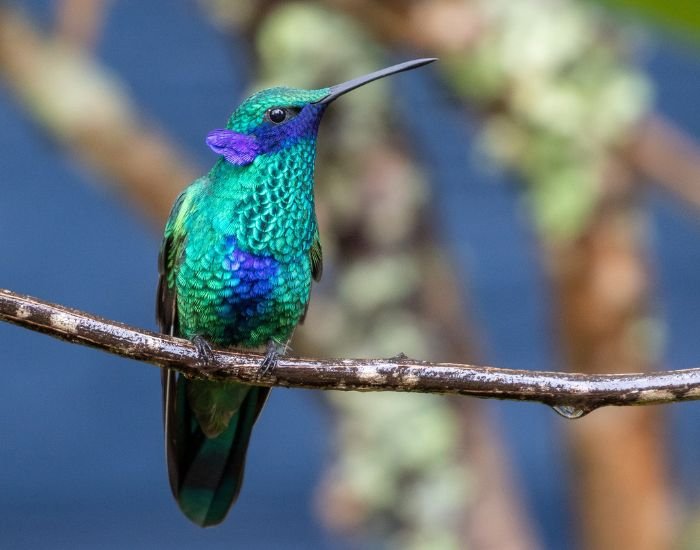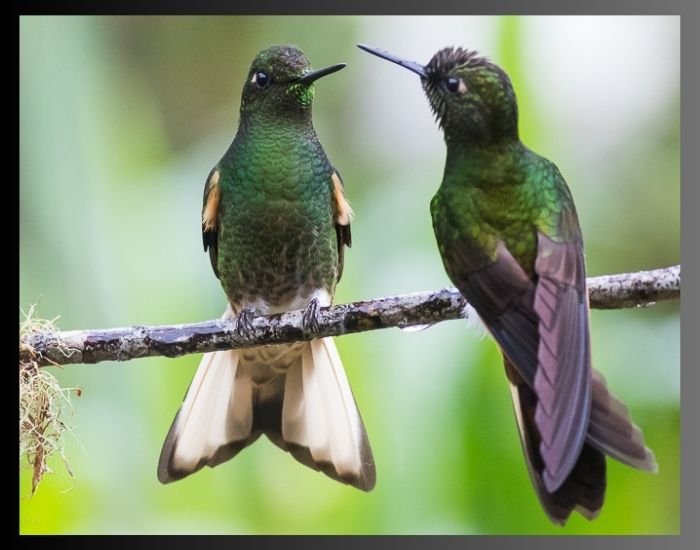
Hummingbirds are some of the most beautiful birds in the world. They are also known for their long tails, which they use for a variety of purposes.
Some hummingbirds have long tails to attract mates. The males of these species will often fan their tails out to show off their plumage.
Other hummingbirds have long tails to help them fly. The long tails help stabilize the birds in flight, especially when hovering in front of flowers to feed.
Hummingbirds with Long Tails
Some hummingbirds with long tails include the long-tailed Sylph, Violet-tailed Sylph, Magnificent Spatuletail, Giant Hummingbird, etc.
- Long-tailed Sylph
- Violet-tailed Sylph
- Magnificent Spatuletail
- Sword-billed Hummingbird
- Sparkling Violetear
- Buff-tailed Coronet
- Giant Hummingbird
1. Long-tailed Sylph

The Long-tailed Sylph is a hummingbird in the Andes Mountains of South America. It’s medium-sized, with males having bright blue heads and long tails, while females are less colorful with green heads.
Long-tailed Sylph is one of the most beautiful Hummingbirds in the world.
They live in the Andes, mostly in cloud forests and other high-altitude forests, around 2,000 to 3,000 meters up.
These birds eat flower nectar and small bugs. When males want to impress females, they do a cool hovering dance.
Read More: 20 Hummingbirds Size: Smallest to Largest Species
During breeding, females make nests out of plant bits, moss, and lichens, laying two eggs. About 15 days later, the eggs hatch, and the baby birds fly away about 22 days later.
Long-tailed Sylphs are the biggest in their hummingbird family, with males reaching up to 12 inches long, including their tails. They’re not at risk of disappearing.
You can find them in different places like cloud forests, bamboo forests, and open woodlands. They usually hang out alone but sometimes gather in small groups.
These birds are known for their stunning colors and fancy dances, making them a cool part of the Andes Bird Club.
2. Violet-tailed Sylph

The Violet-tailed Sylph is a lovely hummingbird found in the Andes Mountains of Ecuador and Colombia. These birds have some special features.
Male Violet-tailed Sylphs are mostly green with a blue-green throat, and they have a long, split tail that shimmers in purple and blue. Females look different with an orange belly and white breast.
In terms of size, they’re about 9 inches long, and males usually have longer tails. They eat nectar from flowers and small insects and can often be seen near the edges of forests.
Read More: Allen’s Hummingbird vs. Amazilia Hummingbird
While they mostly like to be alone, sometimes they hang out in small groups. They have babies from January to April, with the female laying two eggs in a mossy nest.
The good news is that Violet-tailed Sylphs are doing okay and aren’t considered endangered. They’re a wonderful part of the Andes Mountains’ natural beauty.
3. Magnificent Spatuletail

The Marvelous Spatuletail is a special hummingbird living in the cloud forests of northern Peru. These birds have some unique features.
Marvelous Spatuletail hummingbird species are the most colorful hummingbirds in the world.
The male Marvelous Spatuletail is about 5 inches long, with a super long, split tail that can reach up to 8 inches.
This tail has shiny green and blue feathers with two spatula-shaped tips. The male also has a blue crown and a green throat.
Females are smaller and less colorful, with green on their backs and a white throat.
They eat nectar from flowers and tiny insects and can be found flying around in the lower parts of the forest.
Usually, Marvelous Spatuletails like to be alone, but sometimes they hang out in small groups when they’re eating.
They have babies from April to July, and the female lays two eggs in a nest made from moss and lichens.
The sad news is that Marvelous Spatuletails are in danger. Their numbers are going down because they’re losing their homes, and the climate is changing.
These fantastic birds need our help to make sure they survive in Peru’s cloud forests.
Read More: Allen’s Hummingbird vs. Amethyst Woodstar
4. Sword-billed Hummingbird

The Sword-billed Hummingbird (Ensifera ensifera) is the biggest around, measuring up to 14 centimeters (5.5 inches) long without its bill.
What makes it stand out is its giant bill, which can be 8-12 centimeters (3.1-4.7 inches) long.
It has the largest bill of any hummingbird and the biggest one compared to its body size in the bird world.
These birds call the Andean mountains of Colombia, Ecuador, and Peru home, living in places like cloud forests and high meadows at elevations of 2,400 to 3,500 meters (7,900 to 11,500 feet).
Read More: 23 Amazing Hummingbird Facts That Will Blow Your Mind (2023)
They dine on nectar from long, tube-like flowers, using their lengthy bills to reach the nectar at the bottom. Although they’re usually solitary, they might hang out in small groups when they’re feeding.
The Sword-billed Hummingbird’s breeding season happens from March to July, and during this time, the female lays two eggs in a nest made of moss and lichens.
The good news is that these hummingbirds are doing okay and aren’t considered endangered. They’re quite a unique and fascinating species in the hummingbird world.
5. Sparkling Violetear

The Sparkling Violetear (Colibri coruscans) is a medium-sized hummingbird, measuring around 10 inches long.
The males have a shiny blue throat and belly, along with a greenback. Females are similar but with a less vivid blue throat.
These hummingbirds call the Andes Mountains of Colombia and Ecuador their home, residing at elevations ranging from 1,000 to 4,500 meters (3,300 to 14,800 feet).
They prefer open spaces like forest edges, shrubby areas, and gardens. Their diet includes nectar from flowers and small insects.
Luckily, the Sparkling Violetear is a common species and isn’t considered to be in danger.
6. Buff-tailed Coronet

The Buff-tailed Coronet (Boissonneaua flavescens) is a beautiful hummingbird known for its green and white feathers and a special buff-colored tail.
These graceful birds can be found in South America, where they visit flowers, sip nectar, and help plants make seeds by spreading pollen. Luckily, these lovely birds are doing well and aren’t in danger.
They add to the beauty of their habitats in South America.
7. Giant Hummingbird

The Giant Hummingbird (Patagonia gigas) is the biggest globally, measuring up to a whopping 23 centimeters (9.1 inches) long, not including its bill.
These impressive birds live in the Andes Mountains of Chile and Argentina, high up at 1,000 to 3,500 meters (3,300 to 11,500 feet) above sea level.
Males have green backs and white throats, while females look quite similar but with a bit less green on their backs. These birds are a bit shy and prefer to flutter through the undergrowth of the forest. They mainly eat nectar from flowers and sometimes nibble on small insects.
Despite their size and being rare, the good news is that the Giant Hummingbird is not considered to be at risk of disappearing. This is great news for these unique hummingbirds that call the Andes home.
Conclusion
Hummingbirds with long tails are a wonder to behold. Their beauty and grace are unmatched in the bird world. Whether they are using their tails to attract mates, fly, or camouflage themselves, hummingbird tails are a marvel of nature.

